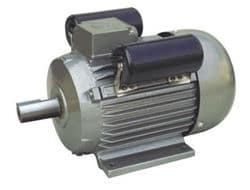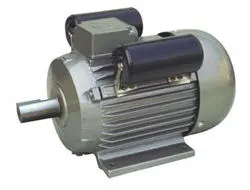
Induction Machines as Generators
Using Induction Machines as Generators
![]() Induction machines are well suited for use as an electrical generator and are a common type of electrical machine. As well as solar energy, wind energy generation has become an important part of a home owners small scale renewable energy system.
Induction machines are well suited for use as an electrical generator and are a common type of electrical machine. As well as solar energy, wind energy generation has become an important part of a home owners small scale renewable energy system.
There are several generic types of generator available as possible candidates for use as a wind or hydro turbine generator, but perhaps the most common type of electrical machines used throughout the industry are induction machines.
Induction Machines in the form of induction generators, also known as an “asynchronous generator” are commonly used for small scale schemes due to advantages such as simplicity, availability, robustness and more importantly their low cost. Also as induction generators (IG’s) are brushless (that is they have no commutator or carbon brushes) they require very little in the way of control systems or maintenance, generally just a clean and bearing lubrication throughout their life.

An induction generator looks a lot like an induction motor used in industry and it is, the difference is when the machine is rotated faster than its normal operating speed, an induction generator produces AC electricity.
The cost per kilowatt (kW) of a single-phase induction generator is generally higher than that of a three-phase generator for the same size per kilowatt of output power. Therefore, three-phase generators, which can also produce a single-phase voltage output, are normally used.
Most home made small scale systems are designed to operate in parallel with the utility grid, supplying a fraction of the home owners total power needs. An induction generator is capable of producing grid-compatible AC power without the use of an additional inverter or electronic controls as it synchronizes with the grid — that is, produces electricity at the same frequency and voltage.
In such operations the generators voltage and frequency output is maintained within acceptable utility company limits by connecting a resistive ballast which maintains the sum of the consumer load and the ballast load at a constant value. Also static capacitors are sometimes used for power-factor correction and to provide excitation to the machine.
The squirrel-cage induction machine in wind and hydro generation is widely accepted as the generator of choice. Usually a wind turbine generator is more difficult to control than hydro generators because their speed and therefore power output varies so widely.
But as the induction generator is connected to the utility grid at a constant frequency, so no synchronizing equipment is necessary, the induction generator operates at practically constant speed (within a small range of slip). So when used as a wind turbine, it operates in optimum efficiency only within a small range of wind speed variation.
An induction machine does not have a predefined speed of rotation for a given frequency and voltage as with the operation of a synchronous generator, but its speed with a constant mains frequency can vary with the load. The power delivered by the generator varies as the machine speed changes.
At synchronous speed, that is the rotational speed exactly equal to the AC frequency, no power is generated at all. The difference between the generators synchronous speed and actual speed is called the “slip”. The machines torque and power vary linearly with the slip.
If the generators slip is controlled in accordance with the load requirements, the induction generator will deliver the necessary power. Synchronous speed is a function of the electrical frequency while the actual speed is determined by the water or wind turbine connected to the generator shaft. Therefore to generate power, the induction generator must rotate faster than the slip speed.
Clearly for small-scale generation, the induction machine when used as a generator converts potential energy to kinetic energy then electric energy. The rotor spins above synchronous speed and develops a counter-torque that opposes this over-speed, same effect as a brake.
The generators rotor returns the power as electrical energy instead of dissipating it as heat, commonly referred to as asynchronous generation. Then kinetic energy is converted into electrical energy and the generator delivers active power to the electrical grid.
However to operate successfully the electrical utility grid must also provide reactive power to create the stator’s rotating magnetic field. That is an induction generator receives its excitation or magnetizing current directly from the utility grid. Then an induction generator consumes rather than supplies reactive power (KVAR) and supplies only real power (KW) directly to the grid.
Motors can usually function as generators, and vice versa, and since the induction generator is actually an induction motor being driven by a turbine called the prime mover, it has several advantages over other types of generators.
Advantages of Induction Machines as Generators
- They are less expensive and more readily available than an equivalent synchronous generator.
- They do not use slip rings to pass current to the field coils in the rotor.
- Induction generators do not require an external DC field excitation voltage.
- Electrical current is induced in the rotor windings by transformer action
- They automatically synchronizes with the power system, so its controls are simpler and less expensive.
Either a three-phase squirrel cage induction machine or a capacitor type induction motor may be used as an induction generator. Of the two choices, the three-phase motor makes a better selection. These machines can usually be found in motor rewind shops, junk yards, salvage yards, etc, fairly cheaply as they are so abundant. Most domestic appliances such as washing machines and driers generally use single-phase induction motors.
The size of the induction machine you use depends on the rating you will need from the generator. Efficiency increases with size but generally it is not necessary to exceed about 10HP ( 7.5kW ) for a three-phase machine or 3HP ( 750W ) for a single-phase machine. Generally, the best induction machines for use as wind turbine generators are rated at 1700 rpm or higher.
To learn more about “Induction Generators”, or obtain more wind energy information about the various wind turbine generating systems available, or to explore the advantages and disadvantages of using induction generators as part of a grid connected wind turbine system, Click Here to get your copy of one of the top three-phase Self-excited Induction Generator books direct from Amazon today.











Which turbine can i use for 7.5kw borehole pump and cost?
Borehole pumps use axial flow impellers due to their high rotational speed
Which motor is more expensive and requires more maintenance.
One that is broken.
Induction Generators with high voltage upto 125 kilovolts and high frequency upto 320 Hz can make our transportation services faster, stronger and more fuel efficient.
Generators are very useful devices which give a sigh of relief in the time of power cut and thus helps in doing usual works in the generator power supply.
I am having a real hard time finding a suitable 12volt dc motor to use as a generator. Simply cant afford to go out and buy and test. I need to maintain a 12volt battery with a low draw of 2amps and a high draw of 16amps. I can spin the generator at a average 600rpm with a high of 1500rpm. Any help or suggestions would be greatly appreciated.:)